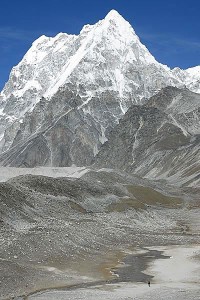
ICT monitor walking down glacial moraine in Nepal.
The ICT team encountered four different groups of refugees, including one group of 26 whose members were suffering from exposure and dehydration. All of the groups had evaded Chinese border patrols on 18,000 foot high glaciated mountain passes and had been walking for several days without food when they met the ICT team.
After administering basic first aid to the feet and face of some of the refugees, the ICT team traveled with one of the groups for several days as they wound their way down into the foothills of Nepal.
With some members of the group suffering from exhaustion, severe blistering on the toes and feet and signs of frostbite, ICT facilitated the evacuation by helicopter of several of the refugees, including two 5-year-olds and two 12-year-olds, while the others continued afoot to Kathmandu.
The recent border mission is part of ICT’s ongoing human rights monitoring and refugee assistance work. During these missions, ICT conducts interviews with refugees, Nepalese police, and Nepalese resident in the mountain communities where refugees pass through. Part of the mission is to provide direct assistance, facilitate communication, and gather vital information to help Tibetans make their way to Kathmandu quickly and safely.
The Kingdom of Nepal, with assistance from the United Nations High Commissioner for Refugees (UNHCR), allows Tibetan refugees transit through Nepal en route to their destination in India. There are, however, regular problems with abuse, beatings, and deportations of Tibetans by Nepalese police. This season there have been no reports of deportations of Tibetan refugees.
To read more about the annual refugee exodus, see “Dangerous Crossing, Conditions Impacting the Flight of Tibetan Refugees in 2001“.

